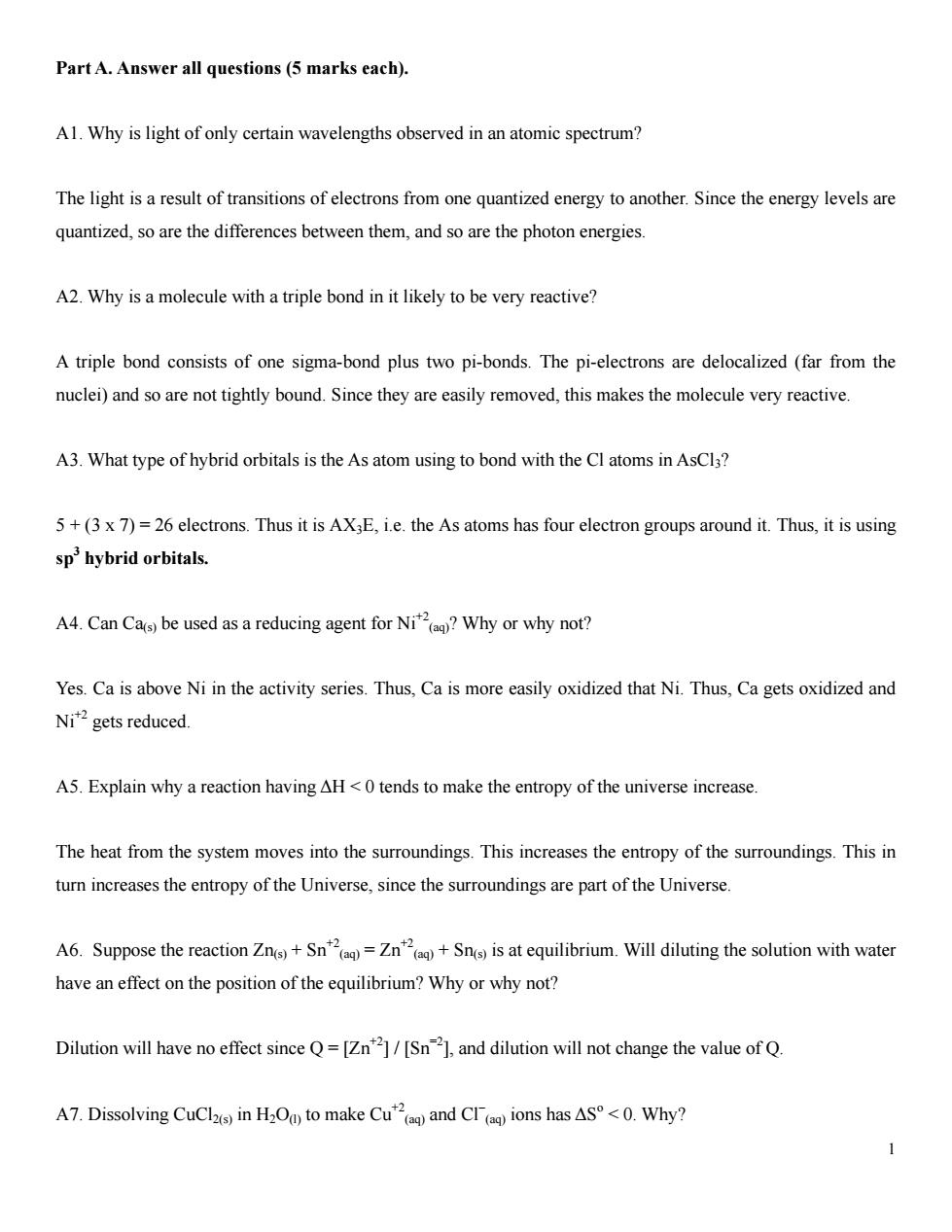正在加载图片...

Part A.Answer all questions(5 marks each) A1.Why is light of only certain wavelengths observed in an atomic spectrum? The light is a result of transitions of electrons from one quantized energy to another.Since the energy levels are quantized,so are the differences between them,and so are the photon energies. A2.Why is a molecule with a triple bond in it likely to be very reactive? A triple bond consists of one sigma-bond plus two pi-bonds.The pi-electrons are delocalized (far from the nuclei)and so are not tightly bound.Since they are easily removed,this makes the molecule very reactive. A3.What type of hybrid orbitals is the As atom using to bond with the Cl atoms in AsCl3? 5+(3x7)=26 electrons.Thus it is AXE,i.e.the As atoms has four electron groups around it.Thus,it is using sphybrid orbitals A4.Can Cas be used as a reducing agent for Ni?Why or why not? Yes.Ca is above Ni in the activity series.Thus,Ca is more easily oxidized that Ni.Thus,Ca gets oxidized and Nigets reduced. A5.Explain why a reaction having AH<tends to make the entropy of the universe increase. The heat from the system moves into the surroundings.This increases the entropy of the surroundings.This in turn increases the entropy of the Universe,since the surroundings are part of the Universe. A6.Suppose the reaction Zn+Sn=Zn+Sn(s)is at equilibrium.Will diluting the solution with water have an effect on the position of the equilibrium?Why or why not? Dilution will have no effect since Q=[Zn][Sn]and dilution will not change the value ofQ A7.Dissolving CuCls in HO to make Cu and Cl ions has AS<0.Why?1 Part A. Answer all questions (5 marks each). A1. Why is light of only certain wavelengths observed in an atomic spectrum? The light is a result of transitions of electrons from one quantized energy to another. Since the energy levels are quantized, so are the differences between them, and so are the photon energies. A2. Why is a molecule with a triple bond in it likely to be very reactive? A triple bond consists of one sigma-bond plus two pi-bonds. The pi-electrons are delocalized (far from the nuclei) and so are not tightly bound. Since they are easily removed, this makes the molecule very reactive. A3. What type of hybrid orbitals is the As atom using to bond with the Cl atoms in AsCl3? 5 + (3 x 7) = 26 electrons. Thus it is AX3E, i.e. the As atoms has four electron groups around it. Thus, it is using sp3 hybrid orbitals. A4. Can Ca(s) be used as a reducing agent for Ni+2 (aq)? Why or why not? Yes. Ca is above Ni in the activity series. Thus, Ca is more easily oxidized that Ni. Thus, Ca gets oxidized and Ni+2 gets reduced. A5. Explain why a reaction having ΔH < 0 tends to make the entropy of the universe increase. The heat from the system moves into the surroundings. This increases the entropy of the surroundings. This in turn increases the entropy of the Universe, since the surroundings are part of the Universe. A6. Suppose the reaction Zn(s) + Sn+2 (aq) = Zn+2 (aq) + Sn(s) is at equilibrium. Will diluting the solution with water have an effect on the position of the equilibrium? Why or why not? Dilution will have no effect since Q = [Zn+2] / [Sn=2], and dilution will not change the value of Q. A7. Dissolving CuCl2(s) in H2O(l) to make Cu+2 (aq) and Cl− (aq) ions has ΔSo < 0. Why?